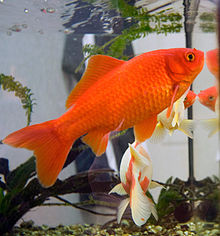Goldfish
| Goldfish | |
|---|---|
 |
|
|
Domesticated
|
|
| Scientific classification | |
| Kingdom: | Animalia |
| Phylum: | Chordata |
| Class: | Actinopterygii |
| Order: | Cypriniformes |
| Family: | Cyprinidae |
| Genus: | Carassius |
| Species: | C. auratus |
| Binomial name | |
|
Carasius auratus (Linnaeus, 1758) |
|
The goldfish (Carassius auratus) is a freshwater fish in the family Cyprinidae of order Cypriniformes. It was one of the earliest fish to be domesticated, and is one of the most commonly kept aquarium fish.
A relatively small member of the carp family (which also includes the koi carp and the crucian carp), the goldfish is a domesticated version of a less-colourful carp (Carassius auratus) native to east Asia. It was first domesticated in China more than a thousand years ago, and several distinct breeds have since been developed. Goldfish breeds vary greatly in size, body shape, fin configuration and colouration (various combinations of white, yellow, orange, red, brown, and black are known).
The mutation that gave rise to the domestic goldfish is also known from other cyprinid species, such as common carp and tench.
Starting in ancient China, various species of carp (collectively known as Asian carp) have been domesticated and reared as food fish for thousands of years. Some of these normally gray or silver species have a tendency to produce red, orange or yellow colour mutations; this was first recorded during the Jin dynasty (265–420).
During the Tang dynasty (618–907), it was popular to raise carp in ornamental ponds and watergardens. A natural genetic mutation produced gold (actually yellowish orange) rather than silver colouration. People began to breed the gold variety instead of the silver variety, keeping them in ponds or other bodies of water. On special occasions at which guests were expected, they would be moved to a much smaller container for display.
...
Wikipedia
